Business Finance Report: MOD003319, Semester 2 Analysis and Budgeting
VerifiedAdded on 2023/01/05
|16
|3289
|21
Report
AI Summary
This report provides a comprehensive analysis of business finance, covering key areas such as business performance analysis, understanding financial information, and cash management. The report begins with an examination of the statement of profit and loss, including the calculation and interpretation of gross profit ratio, net profit ratio, and operating profit ratio. It then proceeds to analyze the statement of financial position, focusing on current ratio, receivable turnover ratio, and payable turnover ratio. The second part of the report delves into the differences between accruals and cash accounting, highlighting their advantages and disadvantages, and explaining the relationship between profit and cash flows. Finally, the report explores the meaning and purposes of budgeting and the benefits of forming a limited company and getting it registered on a stock exchange. The analysis is supported by financial data and ratios, providing a clear understanding of the company's financial health and performance.
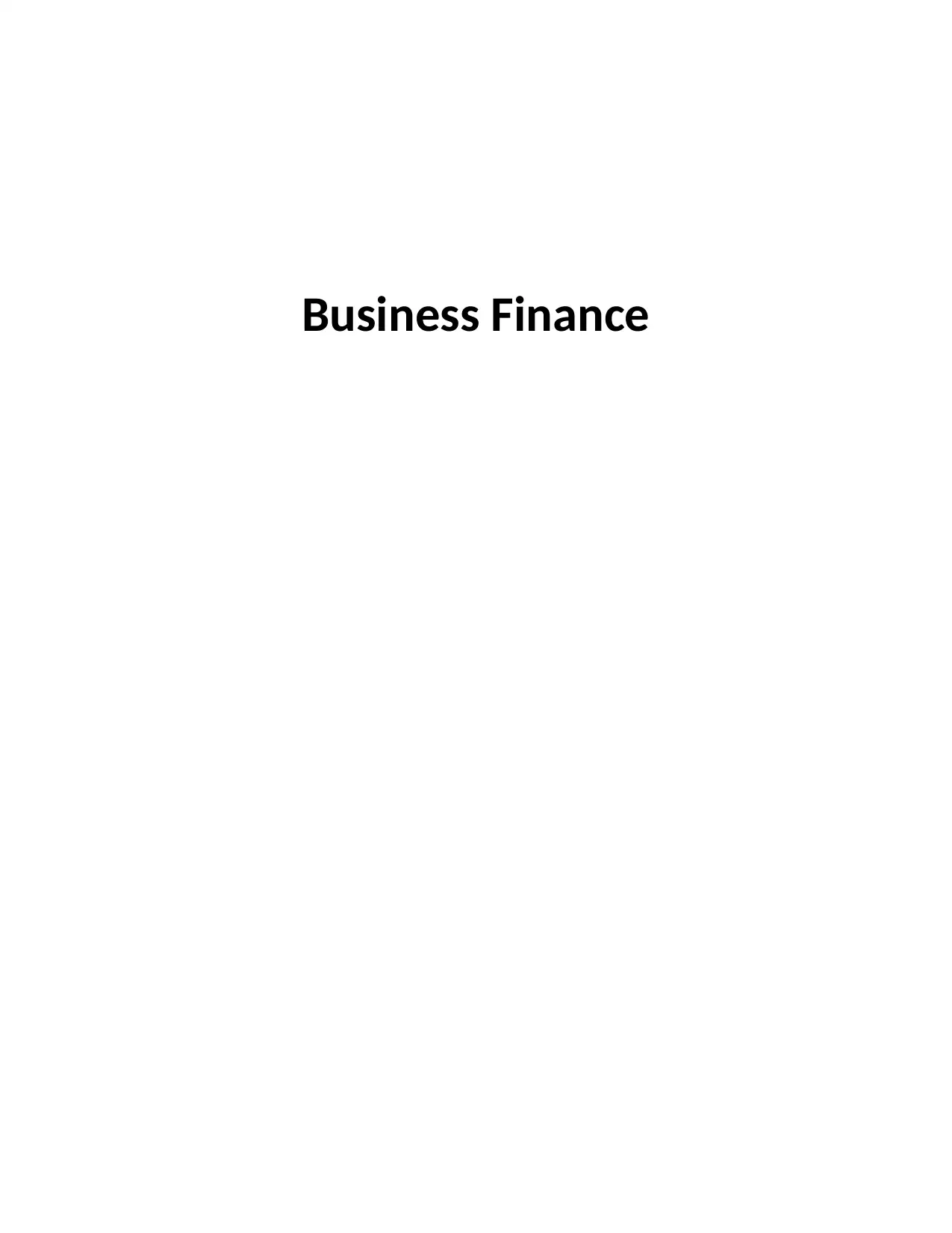
Business Finance
Paraphrase This Document
Need a fresh take? Get an instant paraphrase of this document with our AI Paraphraser
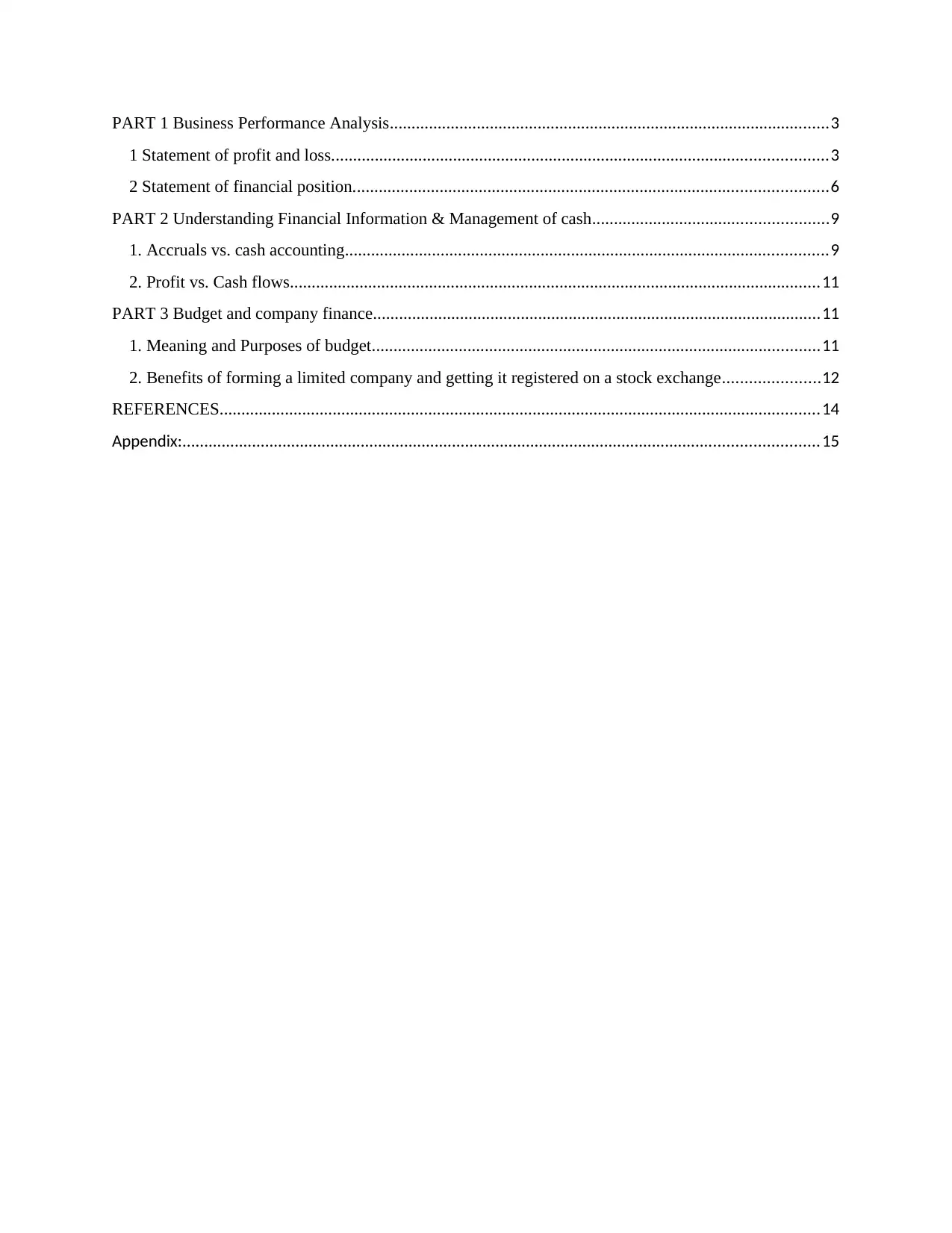
PART 1 Business Performance Analysis.....................................................................................................3
1 Statement of profit and loss..................................................................................................................3
2 Statement of financial position.............................................................................................................6
PART 2 Understanding Financial Information & Management of cash......................................................9
1. Accruals vs. cash accounting...............................................................................................................9
2. Profit vs. Cash flows..........................................................................................................................11
PART 3 Budget and company finance.......................................................................................................11
1. Meaning and Purposes of budget.......................................................................................................11
2. Benefits of forming a limited company and getting it registered on a stock exchange......................12
REFERENCES..........................................................................................................................................14
Appendix:..................................................................................................................................................15
1 Statement of profit and loss..................................................................................................................3
2 Statement of financial position.............................................................................................................6
PART 2 Understanding Financial Information & Management of cash......................................................9
1. Accruals vs. cash accounting...............................................................................................................9
2. Profit vs. Cash flows..........................................................................................................................11
PART 3 Budget and company finance.......................................................................................................11
1. Meaning and Purposes of budget.......................................................................................................11
2. Benefits of forming a limited company and getting it registered on a stock exchange......................12
REFERENCES..........................................................................................................................................14
Appendix:..................................................................................................................................................15
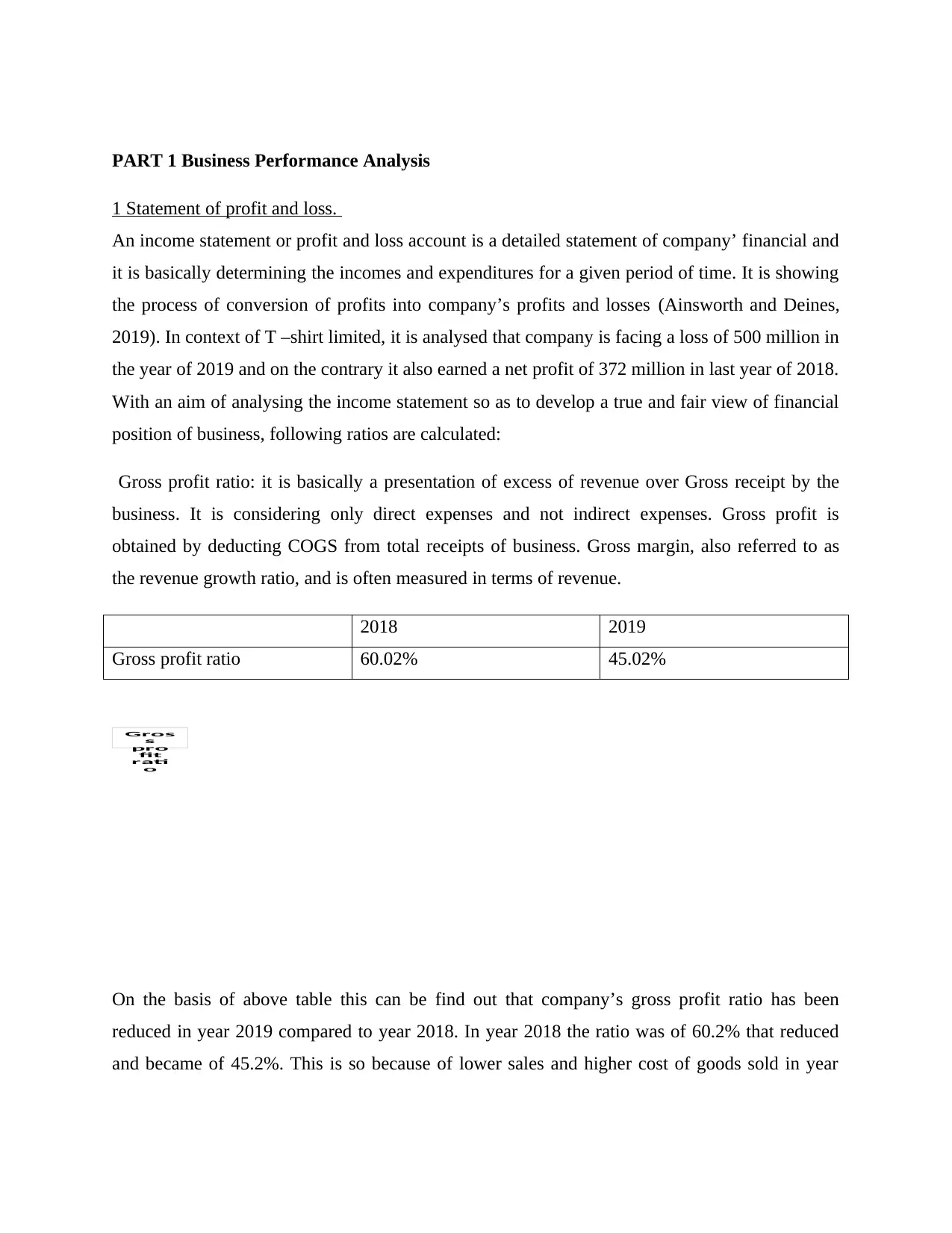
PART 1 Business Performance Analysis
1 Statement of profit and loss.
An income statement or profit and loss account is a detailed statement of company’ financial and
it is basically determining the incomes and expenditures for a given period of time. It is showing
the process of conversion of profits into company’s profits and losses (Ainsworth and Deines,
2019). In context of T –shirt limited, it is analysed that company is facing a loss of 500 million in
the year of 2019 and on the contrary it also earned a net profit of 372 million in last year of 2018.
With an aim of analysing the income statement so as to develop a true and fair view of financial
position of business, following ratios are calculated:
Gross profit ratio: it is basically a presentation of excess of revenue over Gross receipt by the
business. It is considering only direct expenses and not indirect expenses. Gross profit is
obtained by deducting COGS from total receipts of business. Gross margin, also referred to as
the revenue growth ratio, and is often measured in terms of revenue.
2018 2019
Gross profit ratio 60.02% 45.02%
Gros
s
pro
fit
rati
o
On the basis of above table this can be find out that company’s gross profit ratio has been
reduced in year 2019 compared to year 2018. In year 2018 the ratio was of 60.2% that reduced
and became of 45.2%. This is so because of lower sales and higher cost of goods sold in year
1 Statement of profit and loss.
An income statement or profit and loss account is a detailed statement of company’ financial and
it is basically determining the incomes and expenditures for a given period of time. It is showing
the process of conversion of profits into company’s profits and losses (Ainsworth and Deines,
2019). In context of T –shirt limited, it is analysed that company is facing a loss of 500 million in
the year of 2019 and on the contrary it also earned a net profit of 372 million in last year of 2018.
With an aim of analysing the income statement so as to develop a true and fair view of financial
position of business, following ratios are calculated:
Gross profit ratio: it is basically a presentation of excess of revenue over Gross receipt by the
business. It is considering only direct expenses and not indirect expenses. Gross profit is
obtained by deducting COGS from total receipts of business. Gross margin, also referred to as
the revenue growth ratio, and is often measured in terms of revenue.
2018 2019
Gross profit ratio 60.02% 45.02%
Gros
s
pro
fit
rati
o
On the basis of above table this can be find out that company’s gross profit ratio has been
reduced in year 2019 compared to year 2018. In year 2018 the ratio was of 60.2% that reduced
and became of 45.2%. This is so because of lower sales and higher cost of goods sold in year
⊘ This is a preview!⊘
Do you want full access?
Subscribe today to unlock all pages.

Trusted by 1+ million students worldwide
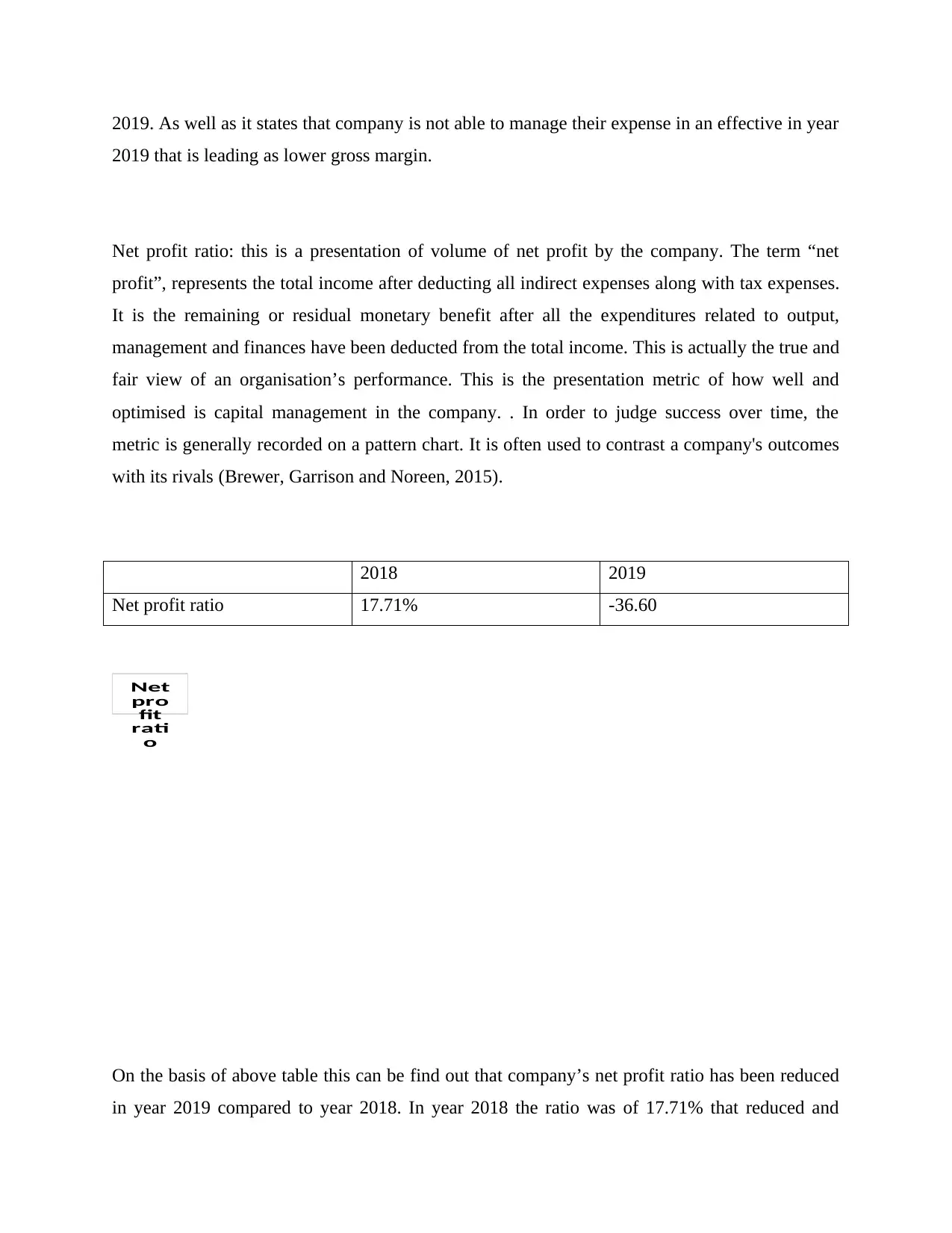
2019. As well as it states that company is not able to manage their expense in an effective in year
2019 that is leading as lower gross margin.
Net profit ratio: this is a presentation of volume of net profit by the company. The term “net
profit”, represents the total income after deducting all indirect expenses along with tax expenses.
It is the remaining or residual monetary benefit after all the expenditures related to output,
management and finances have been deducted from the total income. This is actually the true and
fair view of an organisation’s performance. This is the presentation metric of how well and
optimised is capital management in the company. . In order to judge success over time, the
metric is generally recorded on a pattern chart. It is often used to contrast a company's outcomes
with its rivals (Brewer, Garrison and Noreen, 2015).
2018 2019
Net profit ratio 17.71% -36.60
Net
pro
fit
rati
o
On the basis of above table this can be find out that company’s net profit ratio has been reduced
in year 2019 compared to year 2018. In year 2018 the ratio was of 17.71% that reduced and
2019 that is leading as lower gross margin.
Net profit ratio: this is a presentation of volume of net profit by the company. The term “net
profit”, represents the total income after deducting all indirect expenses along with tax expenses.
It is the remaining or residual monetary benefit after all the expenditures related to output,
management and finances have been deducted from the total income. This is actually the true and
fair view of an organisation’s performance. This is the presentation metric of how well and
optimised is capital management in the company. . In order to judge success over time, the
metric is generally recorded on a pattern chart. It is often used to contrast a company's outcomes
with its rivals (Brewer, Garrison and Noreen, 2015).
2018 2019
Net profit ratio 17.71% -36.60
Net
pro
fit
rati
o
On the basis of above table this can be find out that company’s net profit ratio has been reduced
in year 2019 compared to year 2018. In year 2018 the ratio was of 17.71% that reduced and
Paraphrase This Document
Need a fresh take? Get an instant paraphrase of this document with our AI Paraphraser

became of net loss percentage of -36.6%. The rationale behind this is because of higher volume
of operational and finance expenses in year 2019. This shows that company is not effective to
manage their overall expenses and not able to allocate their funds in an appropriate manner.
Operating profit ratio: this is basically the presentation of how effectively is production is done
in the company. This is performed in order to understand the concept of mitigating risk and also
the interest cost. This is a representation of income that company is generating from its
operations in the market (Warren, Jonick and Schneider, 2020). In the formula of this ration,
operating profits are divided by total sales amount and this equation presents the efficiency of
operations. A considerable point in this respect is that, it do not involve any concept which state
that total profit is earned in hard cash.
2018 2019
Operating profit ratio 20.99% -28.84%
Ope
rati
ng
pro
fit
rati
o
On the basis of above chart this can be find out that in year 2019, there is operating loss that is
resulting as operating loss percentage of -28.84%. On the other hands, there was operating profit
of operational and finance expenses in year 2019. This shows that company is not effective to
manage their overall expenses and not able to allocate their funds in an appropriate manner.
Operating profit ratio: this is basically the presentation of how effectively is production is done
in the company. This is performed in order to understand the concept of mitigating risk and also
the interest cost. This is a representation of income that company is generating from its
operations in the market (Warren, Jonick and Schneider, 2020). In the formula of this ration,
operating profits are divided by total sales amount and this equation presents the efficiency of
operations. A considerable point in this respect is that, it do not involve any concept which state
that total profit is earned in hard cash.
2018 2019
Operating profit ratio 20.99% -28.84%
Ope
rati
ng
pro
fit
rati
o
On the basis of above chart this can be find out that in year 2019, there is operating loss that is
resulting as operating loss percentage of -28.84%. On the other hands, there was operating profit
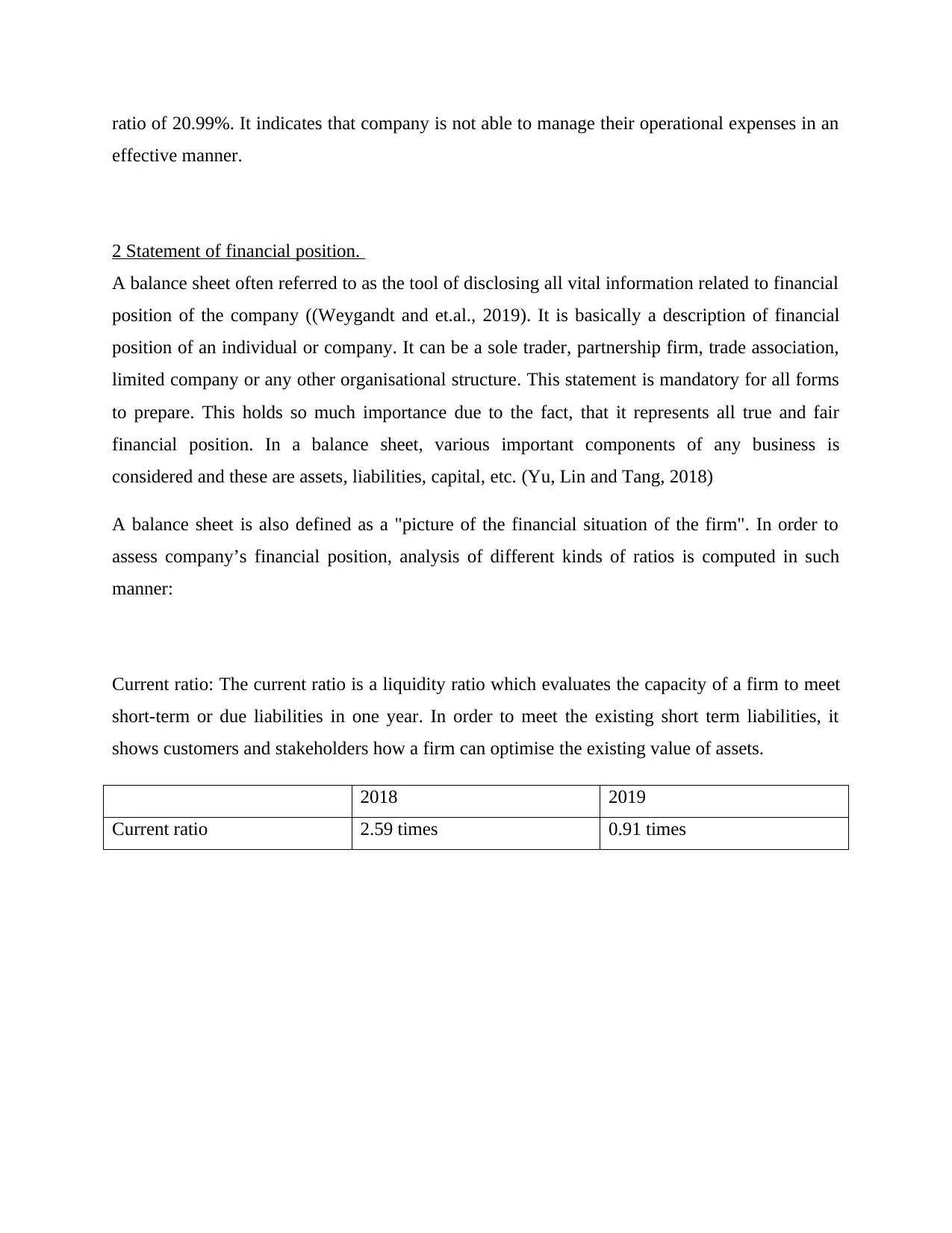
ratio of 20.99%. It indicates that company is not able to manage their operational expenses in an
effective manner.
2 Statement of financial position.
A balance sheet often referred to as the tool of disclosing all vital information related to financial
position of the company ((Weygandt and et.al., 2019). It is basically a description of financial
position of an individual or company. It can be a sole trader, partnership firm, trade association,
limited company or any other organisational structure. This statement is mandatory for all forms
to prepare. This holds so much importance due to the fact, that it represents all true and fair
financial position. In a balance sheet, various important components of any business is
considered and these are assets, liabilities, capital, etc. (Yu, Lin and Tang, 2018)
A balance sheet is also defined as a "picture of the financial situation of the firm". In order to
assess company’s financial position, analysis of different kinds of ratios is computed in such
manner:
Current ratio: The current ratio is a liquidity ratio which evaluates the capacity of a firm to meet
short-term or due liabilities in one year. In order to meet the existing short term liabilities, it
shows customers and stakeholders how a firm can optimise the existing value of assets.
2018 2019
Current ratio 2.59 times 0.91 times
effective manner.
2 Statement of financial position.
A balance sheet often referred to as the tool of disclosing all vital information related to financial
position of the company ((Weygandt and et.al., 2019). It is basically a description of financial
position of an individual or company. It can be a sole trader, partnership firm, trade association,
limited company or any other organisational structure. This statement is mandatory for all forms
to prepare. This holds so much importance due to the fact, that it represents all true and fair
financial position. In a balance sheet, various important components of any business is
considered and these are assets, liabilities, capital, etc. (Yu, Lin and Tang, 2018)
A balance sheet is also defined as a "picture of the financial situation of the firm". In order to
assess company’s financial position, analysis of different kinds of ratios is computed in such
manner:
Current ratio: The current ratio is a liquidity ratio which evaluates the capacity of a firm to meet
short-term or due liabilities in one year. In order to meet the existing short term liabilities, it
shows customers and stakeholders how a firm can optimise the existing value of assets.
2018 2019
Current ratio 2.59 times 0.91 times
⊘ This is a preview!⊘
Do you want full access?
Subscribe today to unlock all pages.

Trusted by 1+ million students worldwide
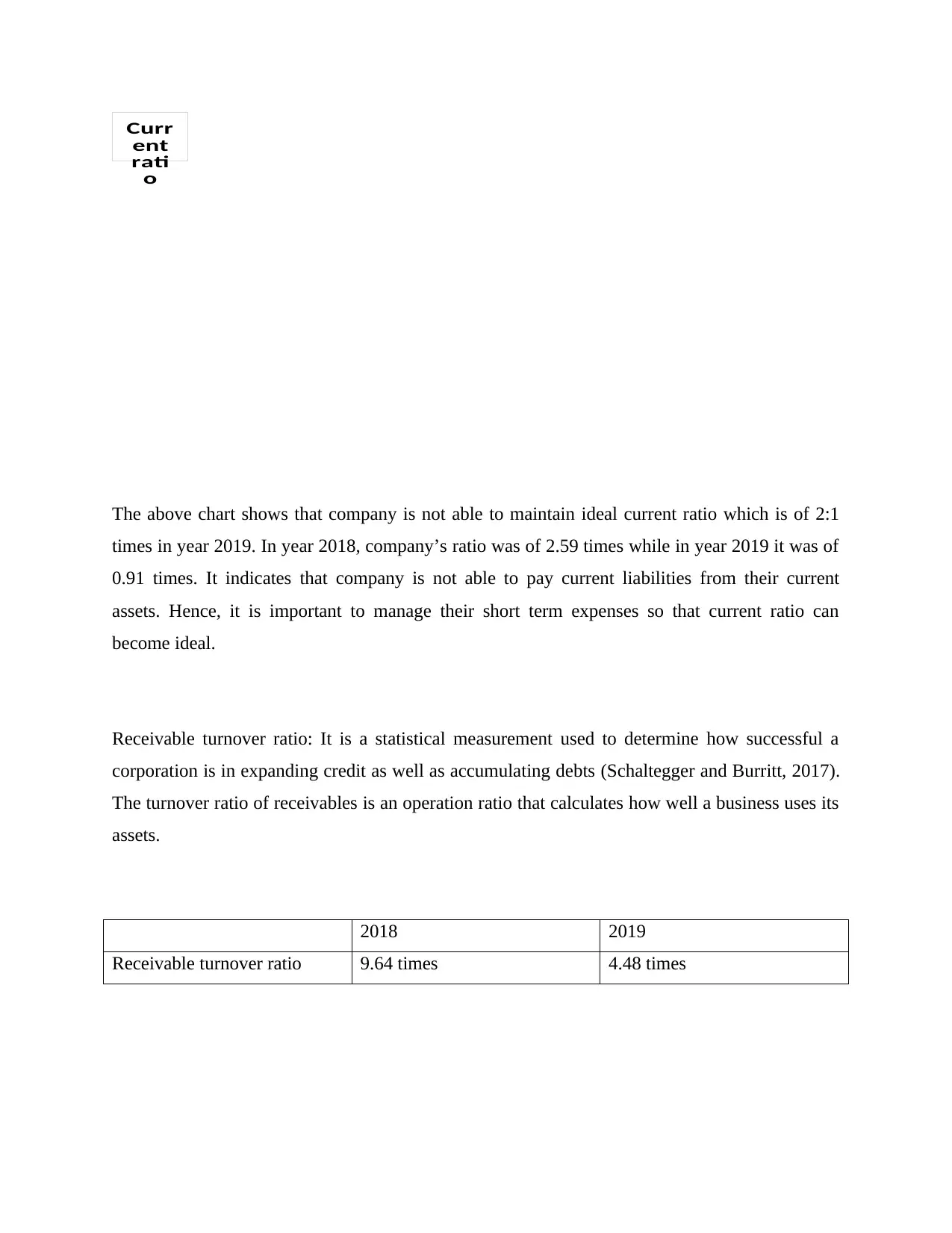
Curr
ent
rati
o
The above chart shows that company is not able to maintain ideal current ratio which is of 2:1
times in year 2019. In year 2018, company’s ratio was of 2.59 times while in year 2019 it was of
0.91 times. It indicates that company is not able to pay current liabilities from their current
assets. Hence, it is important to manage their short term expenses so that current ratio can
become ideal.
Receivable turnover ratio: It is a statistical measurement used to determine how successful a
corporation is in expanding credit as well as accumulating debts (Schaltegger and Burritt, 2017).
The turnover ratio of receivables is an operation ratio that calculates how well a business uses its
assets.
2018 2019
Receivable turnover ratio 9.64 times 4.48 times
ent
rati
o
The above chart shows that company is not able to maintain ideal current ratio which is of 2:1
times in year 2019. In year 2018, company’s ratio was of 2.59 times while in year 2019 it was of
0.91 times. It indicates that company is not able to pay current liabilities from their current
assets. Hence, it is important to manage their short term expenses so that current ratio can
become ideal.
Receivable turnover ratio: It is a statistical measurement used to determine how successful a
corporation is in expanding credit as well as accumulating debts (Schaltegger and Burritt, 2017).
The turnover ratio of receivables is an operation ratio that calculates how well a business uses its
assets.
2018 2019
Receivable turnover ratio 9.64 times 4.48 times
Paraphrase This Document
Need a fresh take? Get an instant paraphrase of this document with our AI Paraphraser
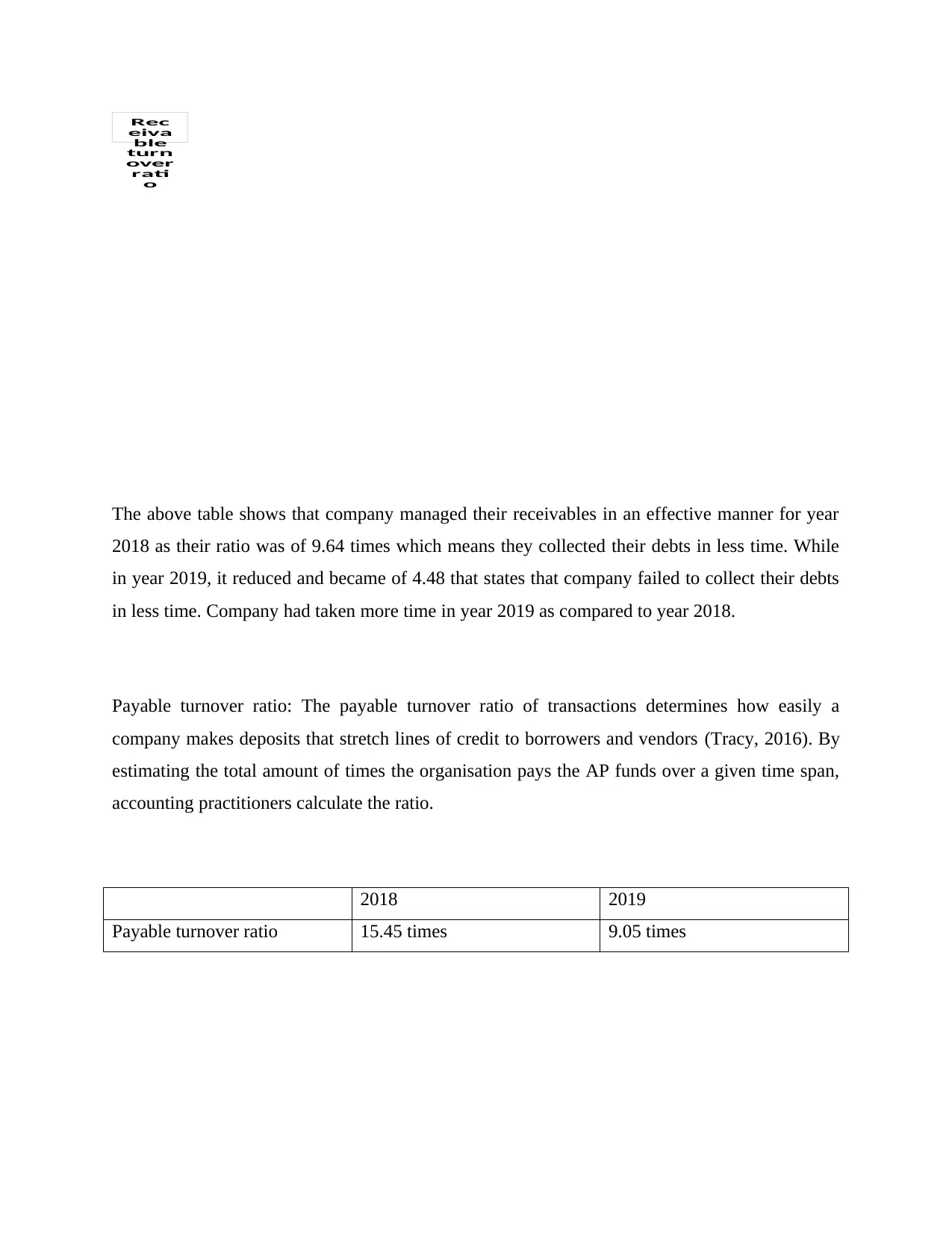
Rec
eiva
ble
turn
over
rati
o
The above table shows that company managed their receivables in an effective manner for year
2018 as their ratio was of 9.64 times which means they collected their debts in less time. While
in year 2019, it reduced and became of 4.48 that states that company failed to collect their debts
in less time. Company had taken more time in year 2019 as compared to year 2018.
Payable turnover ratio: The payable turnover ratio of transactions determines how easily a
company makes deposits that stretch lines of credit to borrowers and vendors (Tracy, 2016). By
estimating the total amount of times the organisation pays the AP funds over a given time span,
accounting practitioners calculate the ratio.
2018 2019
Payable turnover ratio 15.45 times 9.05 times
eiva
ble
turn
over
rati
o
The above table shows that company managed their receivables in an effective manner for year
2018 as their ratio was of 9.64 times which means they collected their debts in less time. While
in year 2019, it reduced and became of 4.48 that states that company failed to collect their debts
in less time. Company had taken more time in year 2019 as compared to year 2018.
Payable turnover ratio: The payable turnover ratio of transactions determines how easily a
company makes deposits that stretch lines of credit to borrowers and vendors (Tracy, 2016). By
estimating the total amount of times the organisation pays the AP funds over a given time span,
accounting practitioners calculate the ratio.
2018 2019
Payable turnover ratio 15.45 times 9.05 times
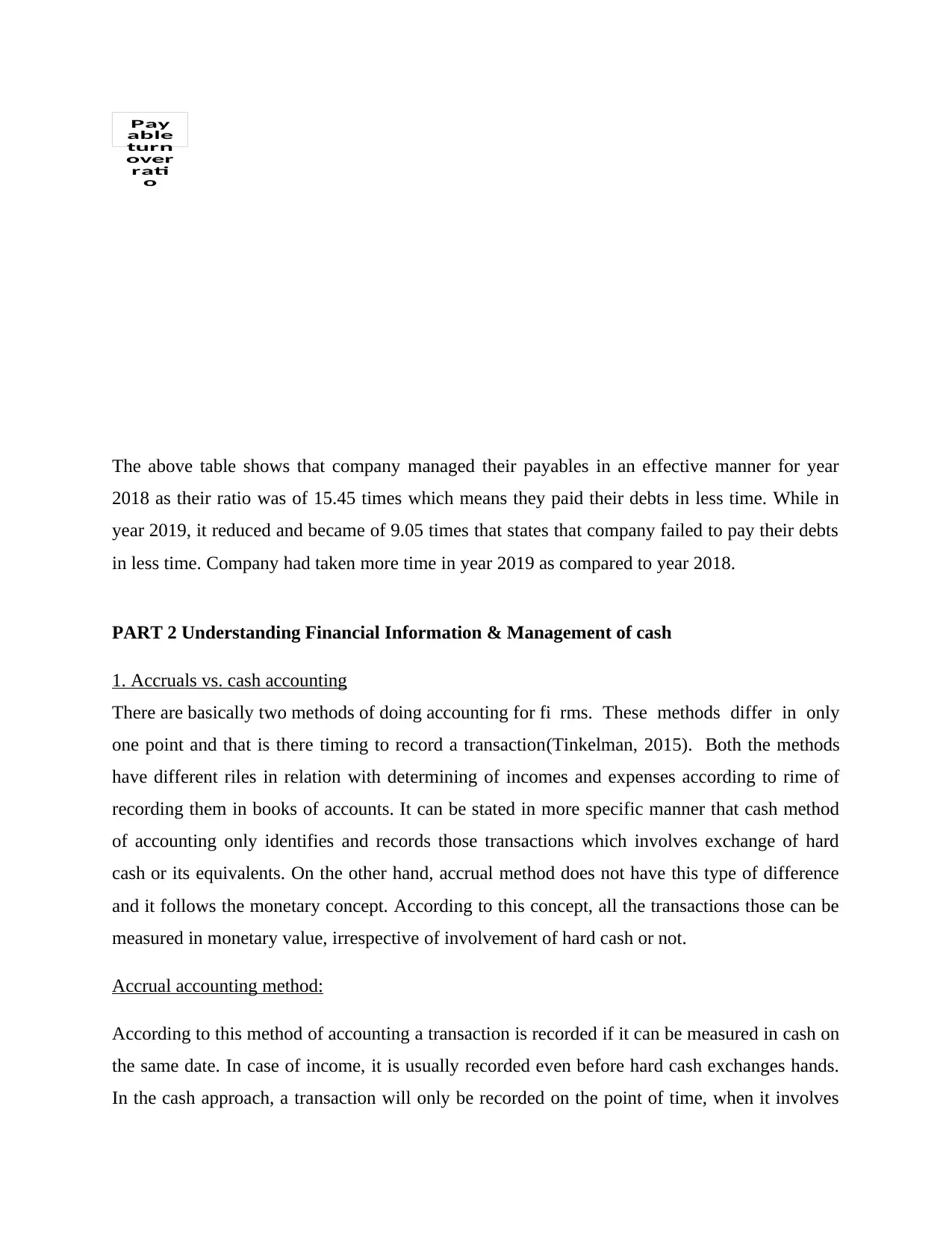
Pay
able
turn
over
rati
o
The above table shows that company managed their payables in an effective manner for year
2018 as their ratio was of 15.45 times which means they paid their debts in less time. While in
year 2019, it reduced and became of 9.05 times that states that company failed to pay their debts
in less time. Company had taken more time in year 2019 as compared to year 2018.
PART 2 Understanding Financial Information & Management of cash
1. Accruals vs. cash accounting
There are basically two methods of doing accounting for fi rms. These methods differ in only
one point and that is there timing to record a transaction(Tinkelman, 2015). Both the methods
have different riles in relation with determining of incomes and expenses according to rime of
recording them in books of accounts. It can be stated in more specific manner that cash method
of accounting only identifies and records those transactions which involves exchange of hard
cash or its equivalents. On the other hand, accrual method does not have this type of difference
and it follows the monetary concept. According to this concept, all the transactions those can be
measured in monetary value, irrespective of involvement of hard cash or not.
Accrual accounting method:
According to this method of accounting a transaction is recorded if it can be measured in cash on
the same date. In case of income, it is usually recorded even before hard cash exchanges hands.
In the cash approach, a transaction will only be recorded on the point of time, when it involves
able
turn
over
rati
o
The above table shows that company managed their payables in an effective manner for year
2018 as their ratio was of 15.45 times which means they paid their debts in less time. While in
year 2019, it reduced and became of 9.05 times that states that company failed to pay their debts
in less time. Company had taken more time in year 2019 as compared to year 2018.
PART 2 Understanding Financial Information & Management of cash
1. Accruals vs. cash accounting
There are basically two methods of doing accounting for fi rms. These methods differ in only
one point and that is there timing to record a transaction(Tinkelman, 2015). Both the methods
have different riles in relation with determining of incomes and expenses according to rime of
recording them in books of accounts. It can be stated in more specific manner that cash method
of accounting only identifies and records those transactions which involves exchange of hard
cash or its equivalents. On the other hand, accrual method does not have this type of difference
and it follows the monetary concept. According to this concept, all the transactions those can be
measured in monetary value, irrespective of involvement of hard cash or not.
Accrual accounting method:
According to this method of accounting a transaction is recorded if it can be measured in cash on
the same date. In case of income, it is usually recorded even before hard cash exchanges hands.
In the cash approach, a transaction will only be recorded on the point of time, when it involves
⊘ This is a preview!⊘
Do you want full access?
Subscribe today to unlock all pages.

Trusted by 1+ million students worldwide
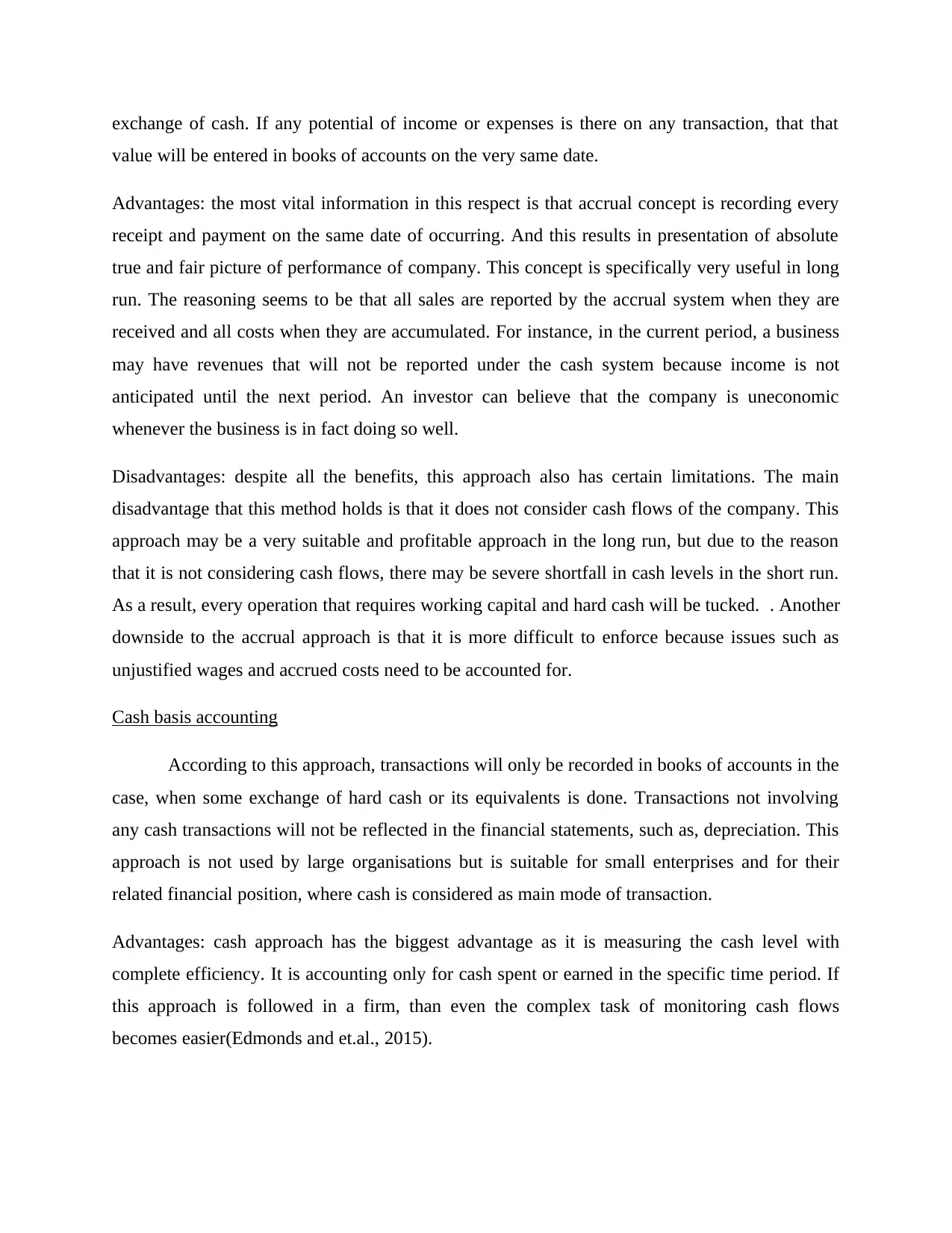
exchange of cash. If any potential of income or expenses is there on any transaction, that that
value will be entered in books of accounts on the very same date.
Advantages: the most vital information in this respect is that accrual concept is recording every
receipt and payment on the same date of occurring. And this results in presentation of absolute
true and fair picture of performance of company. This concept is specifically very useful in long
run. The reasoning seems to be that all sales are reported by the accrual system when they are
received and all costs when they are accumulated. For instance, in the current period, a business
may have revenues that will not be reported under the cash system because income is not
anticipated until the next period. An investor can believe that the company is uneconomic
whenever the business is in fact doing so well.
Disadvantages: despite all the benefits, this approach also has certain limitations. The main
disadvantage that this method holds is that it does not consider cash flows of the company. This
approach may be a very suitable and profitable approach in the long run, but due to the reason
that it is not considering cash flows, there may be severe shortfall in cash levels in the short run.
As a result, every operation that requires working capital and hard cash will be tucked. . Another
downside to the accrual approach is that it is more difficult to enforce because issues such as
unjustified wages and accrued costs need to be accounted for.
Cash basis accounting
According to this approach, transactions will only be recorded in books of accounts in the
case, when some exchange of hard cash or its equivalents is done. Transactions not involving
any cash transactions will not be reflected in the financial statements, such as, depreciation. This
approach is not used by large organisations but is suitable for small enterprises and for their
related financial position, where cash is considered as main mode of transaction.
Advantages: cash approach has the biggest advantage as it is measuring the cash level with
complete efficiency. It is accounting only for cash spent or earned in the specific time period. If
this approach is followed in a firm, than even the complex task of monitoring cash flows
becomes easier(Edmonds and et.al., 2015).
value will be entered in books of accounts on the very same date.
Advantages: the most vital information in this respect is that accrual concept is recording every
receipt and payment on the same date of occurring. And this results in presentation of absolute
true and fair picture of performance of company. This concept is specifically very useful in long
run. The reasoning seems to be that all sales are reported by the accrual system when they are
received and all costs when they are accumulated. For instance, in the current period, a business
may have revenues that will not be reported under the cash system because income is not
anticipated until the next period. An investor can believe that the company is uneconomic
whenever the business is in fact doing so well.
Disadvantages: despite all the benefits, this approach also has certain limitations. The main
disadvantage that this method holds is that it does not consider cash flows of the company. This
approach may be a very suitable and profitable approach in the long run, but due to the reason
that it is not considering cash flows, there may be severe shortfall in cash levels in the short run.
As a result, every operation that requires working capital and hard cash will be tucked. . Another
downside to the accrual approach is that it is more difficult to enforce because issues such as
unjustified wages and accrued costs need to be accounted for.
Cash basis accounting
According to this approach, transactions will only be recorded in books of accounts in the
case, when some exchange of hard cash or its equivalents is done. Transactions not involving
any cash transactions will not be reflected in the financial statements, such as, depreciation. This
approach is not used by large organisations but is suitable for small enterprises and for their
related financial position, where cash is considered as main mode of transaction.
Advantages: cash approach has the biggest advantage as it is measuring the cash level with
complete efficiency. It is accounting only for cash spent or earned in the specific time period. If
this approach is followed in a firm, than even the complex task of monitoring cash flows
becomes easier(Edmonds and et.al., 2015).
Paraphrase This Document
Need a fresh take? Get an instant paraphrase of this document with our AI Paraphraser

Disadvantages: There are several limitation for this approach as well. It could overestimate the
performance of a cash-rich business with vast numbers of accounting records that far outweigh
the cash mostly on accounts and the actual investment portfolio of the business. A shareholder
may believe that the company makes a profit when, in fact, the company makes a loss.
2. Profit vs. Cash flows
The main distinctive features in both terms is that profits are the sum total of all incomes
(whether in cash or not) over total expenses. On the other hand, cash is just a measure of total
income in cash form. This means excess of cash income over total cash expenses.
Cash is the form of exchange tool that is continuously going out and in of company. To
illustrate, when a trader is ordering some stock outside its firm, than he will be giving cash in
exchange of the stocks that are purchase. In this case, when the same retailer who was
purchasing stock from other traders, plans to start selling these stock items, than this cash will
flow out of the business. Business in involved in various transactions like paying salaries, wages
or electric bills and these all transactions also involve some kind exchange of cash. From all
these discussions it is concluded that there is a continuous flow of cash in an organization.
Profits are defined as the amount of income that is remaining with enterprise after making
all expenses. This figure involves every kind of incomes, whether received in form of cash or
not. That's what's left over after the accounts are closed and the expenditures are excluded from
the earnings. Profit can either be paid to owners and stakeholders of the business, often by the
way of dividends distributions, or may be re-invested in company. Profits could be employed, for
instance, to buy new stock for a company to offer or to fund research and developments of new
items and services.
PART 3 Budget and company finance
1. Meaning and Purposes of budget
A budget is defines as the plan or policy of any given company and it is formulates on the
basis of quantitative values. These plans are formulated in financial terms and are for specific
time period that can be either, one month or two year. There are many enterprises are believing
in sticking to their financial budgets throughout the time period and it indicates the estimated
performance of a cash-rich business with vast numbers of accounting records that far outweigh
the cash mostly on accounts and the actual investment portfolio of the business. A shareholder
may believe that the company makes a profit when, in fact, the company makes a loss.
2. Profit vs. Cash flows
The main distinctive features in both terms is that profits are the sum total of all incomes
(whether in cash or not) over total expenses. On the other hand, cash is just a measure of total
income in cash form. This means excess of cash income over total cash expenses.
Cash is the form of exchange tool that is continuously going out and in of company. To
illustrate, when a trader is ordering some stock outside its firm, than he will be giving cash in
exchange of the stocks that are purchase. In this case, when the same retailer who was
purchasing stock from other traders, plans to start selling these stock items, than this cash will
flow out of the business. Business in involved in various transactions like paying salaries, wages
or electric bills and these all transactions also involve some kind exchange of cash. From all
these discussions it is concluded that there is a continuous flow of cash in an organization.
Profits are defined as the amount of income that is remaining with enterprise after making
all expenses. This figure involves every kind of incomes, whether received in form of cash or
not. That's what's left over after the accounts are closed and the expenditures are excluded from
the earnings. Profit can either be paid to owners and stakeholders of the business, often by the
way of dividends distributions, or may be re-invested in company. Profits could be employed, for
instance, to buy new stock for a company to offer or to fund research and developments of new
items and services.
PART 3 Budget and company finance
1. Meaning and Purposes of budget
A budget is defines as the plan or policy of any given company and it is formulates on the
basis of quantitative values. These plans are formulated in financial terms and are for specific
time period that can be either, one month or two year. There are many enterprises are believing
in sticking to their financial budgets throughout the time period and it indicates the estimated
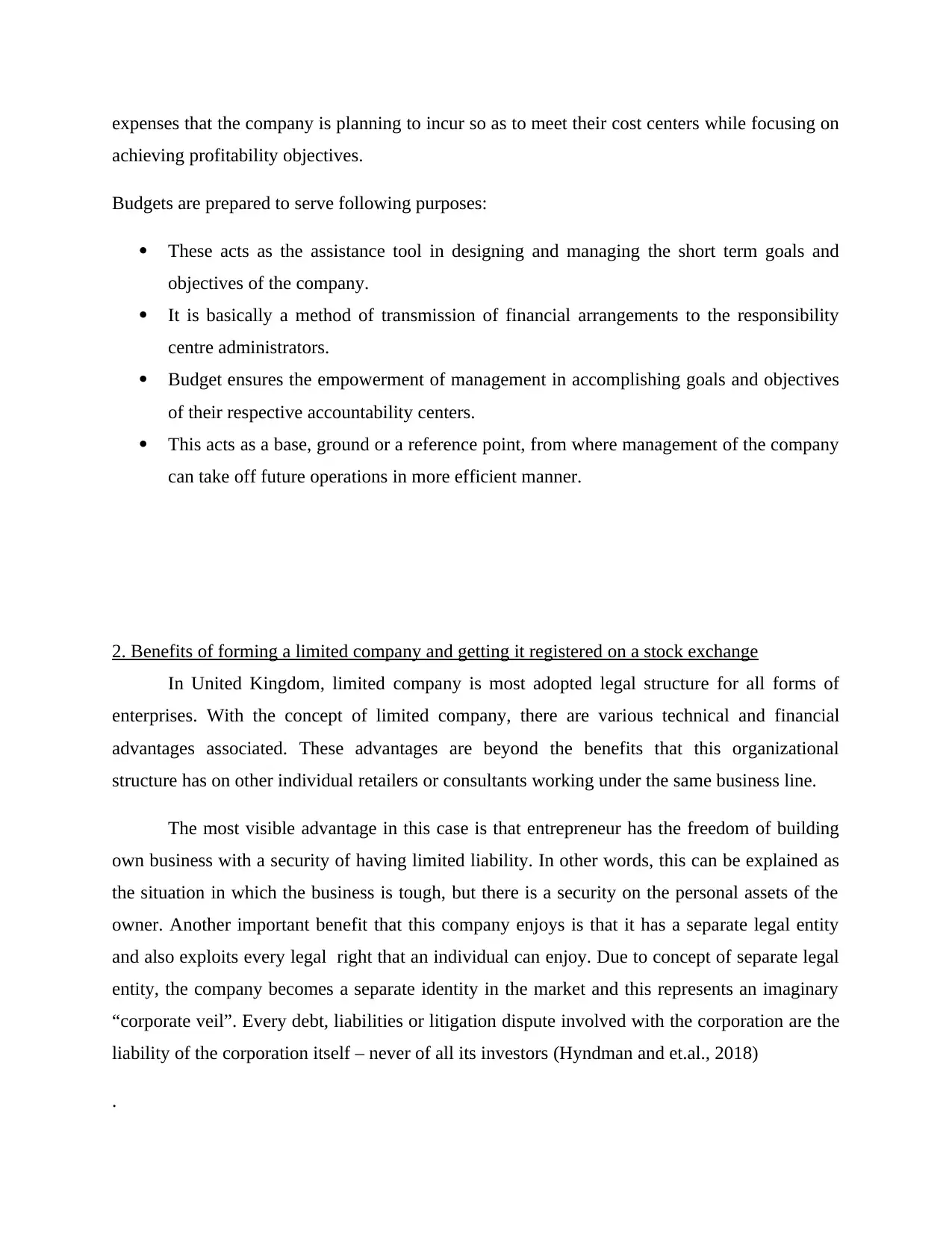
expenses that the company is planning to incur so as to meet their cost centers while focusing on
achieving profitability objectives.
Budgets are prepared to serve following purposes:
These acts as the assistance tool in designing and managing the short term goals and
objectives of the company.
It is basically a method of transmission of financial arrangements to the responsibility
centre administrators.
Budget ensures the empowerment of management in accomplishing goals and objectives
of their respective accountability centers.
This acts as a base, ground or a reference point, from where management of the company
can take off future operations in more efficient manner.
2. Benefits of forming a limited company and getting it registered on a stock exchange
In United Kingdom, limited company is most adopted legal structure for all forms of
enterprises. With the concept of limited company, there are various technical and financial
advantages associated. These advantages are beyond the benefits that this organizational
structure has on other individual retailers or consultants working under the same business line.
The most visible advantage in this case is that entrepreneur has the freedom of building
own business with a security of having limited liability. In other words, this can be explained as
the situation in which the business is tough, but there is a security on the personal assets of the
owner. Another important benefit that this company enjoys is that it has a separate legal entity
and also exploits every legal right that an individual can enjoy. Due to concept of separate legal
entity, the company becomes a separate identity in the market and this represents an imaginary
“corporate veil”. Every debt, liabilities or litigation dispute involved with the corporation are the
liability of the corporation itself – never of all its investors (Hyndman and et.al., 2018)
.
achieving profitability objectives.
Budgets are prepared to serve following purposes:
These acts as the assistance tool in designing and managing the short term goals and
objectives of the company.
It is basically a method of transmission of financial arrangements to the responsibility
centre administrators.
Budget ensures the empowerment of management in accomplishing goals and objectives
of their respective accountability centers.
This acts as a base, ground or a reference point, from where management of the company
can take off future operations in more efficient manner.
2. Benefits of forming a limited company and getting it registered on a stock exchange
In United Kingdom, limited company is most adopted legal structure for all forms of
enterprises. With the concept of limited company, there are various technical and financial
advantages associated. These advantages are beyond the benefits that this organizational
structure has on other individual retailers or consultants working under the same business line.
The most visible advantage in this case is that entrepreneur has the freedom of building
own business with a security of having limited liability. In other words, this can be explained as
the situation in which the business is tough, but there is a security on the personal assets of the
owner. Another important benefit that this company enjoys is that it has a separate legal entity
and also exploits every legal right that an individual can enjoy. Due to concept of separate legal
entity, the company becomes a separate identity in the market and this represents an imaginary
“corporate veil”. Every debt, liabilities or litigation dispute involved with the corporation are the
liability of the corporation itself – never of all its investors (Hyndman and et.al., 2018)
.
⊘ This is a preview!⊘
Do you want full access?
Subscribe today to unlock all pages.

Trusted by 1+ million students worldwide
1 out of 16
Related Documents
Your All-in-One AI-Powered Toolkit for Academic Success.
+13062052269
info@desklib.com
Available 24*7 on WhatsApp / Email
![[object Object]](/_next/static/media/star-bottom.7253800d.svg)
Unlock your academic potential
Copyright © 2020–2025 A2Z Services. All Rights Reserved. Developed and managed by ZUCOL.





